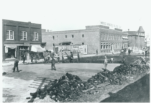Heritage in the Hat: Dreams and schemes
By Sally Sehn on December 28, 2019.
The historic two-and-a-half storey brick home at 111 First St. SW has been described as reflecting the affluence of the owner. Built at a high cost and filled with expensive furnishings, the owner David Brown, was to lose it all within nine years of its construction. Affluence is not the right word. Credit is more realistic. David Walton Brown (1881-1946) was an ambitious man when he uprooted himself from his hometown of Charlottetown, PEI and headed west dreaming to make his fortune. He arrived in Medicine Hat around 1906 and became a real estate agent at the start of the boom market. At the peak of the boom, Brown and three colleagues owned a quarter section of land which was to become Northeast Crescent Heights. In October 1912, these developers donated a portion of this land to the Catholic Corporation for the construction of a Catholic hospital. The donation was well received but instead of a hospital, a fine school was built, St. Theresa’s Academy, now demolished. In the same year, David Brown was a partner in the Medicine Hat Electric Railway Company. The interurban railway was to run from Sixth Avenue and Fourth Street, down Kingsway and have terminals at Dunmore and Elkwater. It was promoted to speed transportation of agricultural products from the south of town. Although the electric railway received a charter from the province, the scheme was voted down in a local bylaw election. In 1912, David Brown married his wife Kate and built the majestic Arts and Crafts residence on First Street SW. The building is made of locally manufactured materials. It was designed by top architect William T. Williams and built by John Pettit. Its furnishings included a bedroom suite in birds-eye maple, a Spanish mahogany dining room set, a piano in the parlour, silk curtains and numerous quality items. The following year, a rear brick garage was built at a cost equivalent to a nice home. With the beginning of the First World War, the real estate market crashed. David continued in the difficult market followed by a short-lived investment in a local brick plant. Hard times proved to be insurmountable. In 1921, the bank had possession of Brown’s First Street home and all its fine furnishings were auctioned off. The Brown family left Canada and moved to Detroit, Mich. Brown became a naturalized U.S. citizen in 1940. But his story doesn’t end there. In 2003, almost six decades after his death, Brown’s granddaughter contacted the Medicine Hat Museum hoping for information about her Canadian grandfather. Passed on to a third generation was a historic photo of the splendid D.W. Brown home, today a First Street S.W. landmark. Sally Sehn is a Member of the Heritage Resources Committee of the City of Medicine Hat. 9-8




